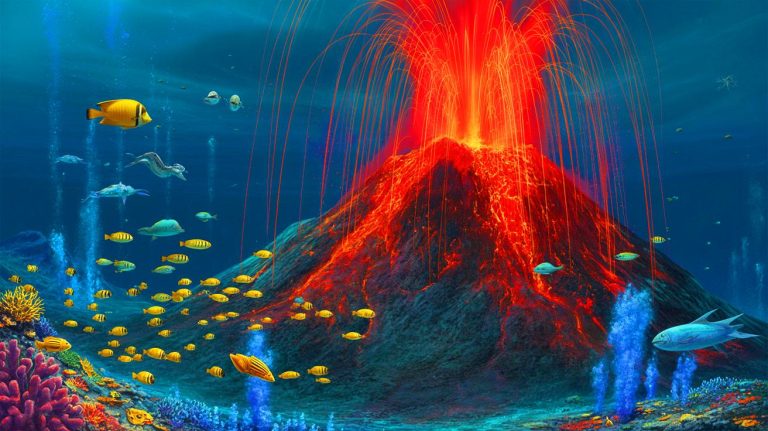| IN A NUTSHELL |
|
Deep beneath the Pacific Ocean, the restless Axial Seamount volcano is stirring once again, sending ripples of anticipation through the scientific community. Located off the coast of Oregon, this underwater giant is showing signs of imminent activity. While predicting the exact timing of an eruption is a complex task, researchers are closely monitoring the situation, as the volcano could erupt as early as this year or possibly tomorrow. This seismic spectacle unfolds nearly a mile beneath the ocean surface, where the Pacific and Juan de Fuca tectonic plates are slowly separating, creating a dramatic and dynamic seafloor landscape.
Magma Rising, Pressure Building
In recent times, Axial Seamount has been steadily inflating with magma, a clear indication of its brewing activity. This buildup is accompanied by an increase in small earthquakes, a harbinger of the volcano’s potential eruption. In 2015, the region experienced a staggering 10,000 earthquakes in just 24 hours as magma flowed from the volcano, creating a 25-mile-long trail underwater. The magma chamber beneath Axial Seamount has collapsed multiple times, forming a deep basin known as a caldera.
Despite the harsh conditions, life thrives around the hydrothermal vents scattered across the caldera floor. These vents release mineral-rich fluids, attracting a vibrant community of microbes and other organisms. Scientists refer to this phenomenon as “snowblowers.” Even after eruptions wipe out these life forms, they astonishingly regenerate within months, showcasing the resilience of life in extreme environments.
Ocean Feels the Shift, Land Remains Unaware
While the underwater activity of Axial Seamount may have profound effects on marine life, it is unlikely to be noticed by people on land. According to experts, the eruptions are not explosive events that produce ash clouds visible above water. Instead, they are more akin to underwater fountains. Historical data suggests that these eruptions are most likely to occur between January and April, as seen in past events in 1998, 2011, and 2015.
The gravitational influence of the moon, combined with seasonal shifts, may play a role in triggering these eruptions. As Earth moves farther from the sun during the early months of the year, the moon’s gravitational pull on ocean tides causes variations in seafloor pressure. When magma is already near the surface, even minor stress changes can lead to an eruption. High tides, in particular, seem to correlate with increased seismic activity, potentially pushing the magma chamber to its limits.
Scientific Endeavors and Public Engagement
Researchers from the National Science Foundation’s Ocean Observatories Initiative, operating the Regional Cabled Array at the University of Washington, are at the forefront of monitoring Axial Seamount. Their work is crucial in understanding the intricate dynamics of this underwater volcano. The observatory plans to livestream future eruptions, providing a unique opportunity for public engagement and education about these fascinating geological events.
By capturing real-time data and imagery, scientists aim to unravel the mysteries of Axial Seamount and its impact on marine ecosystems. The collaboration between geophysicists, marine biologists, and oceanographers is essential in advancing our knowledge of underwater volcanoes and their role in shaping oceanic environments.
The Resilient Ecosystems of Axial Seamount
The resilience of life around Axial Seamount’s hydrothermal vents is a testament to nature’s ability to adapt and thrive in extreme conditions. These ecosystems, once devastated by volcanic eruptions, quickly bounce back, demonstrating the tenacity of life in the ocean’s depths. This phenomenon highlights the potential of underwater volcanoes as major contributors to oceanic biodiversity.
As scientists continue to explore and study these resilient ecosystems, they gain valuable insights into the origins of life on Earth and the potential for life on other planets. The unique conditions found at hydrothermal vents provide a window into the past and a glimpse of what might exist beyond our planet.
As we stand on the brink of another potential eruption of Axial Seamount, the scientific community remains vigilant, ready to capture every moment of this geological spectacle. The mysteries of the deep ocean continue to intrigue and inspire, reminding us of the powerful forces at play beneath the surface. What new discoveries await in the depths of the Pacific, and how will they shape our understanding of the world?
Did you like it? 4.4/5 (23)









Is it safe to watch the livestream? What if it erupts while we’re watching? 😅
Impressive work by the scientists! Thank you for keeping us informed about such important events.
Why is it called Axial Seamount? Is there a story behind the name?
So cool that life can survive under such extreme conditions. Nature is truly amazing. 🌊
Can these eruptions affect the coast of Oregon? Should we worry about tsunamis?
I’m skeptical about how much they can actually predict. Didn’t they say it could happen at any time? 🤔
Can anyone explain what a “caldera” is? I’m not familiar with the term.
Hope the marine life will be okay. Those little creatures are tougher than they look!
Do the seasons really affect underwater volcanoes? That seems a bit far-fetched.